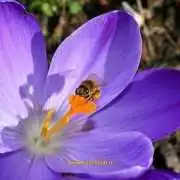پنیر موزارلای شما کش نمیآید یا میسوزد؟ راز آن در علم نهفته است. از فرآیند پاستا فیلاتا تا نقش «کهنگی» و قندها در...
نژادهای مختلف زنبور عسل در جهان: ویژگیها، مزایا و معایب هر نژاد
نژادهای زنبور عسل
مقدمه
زنبور عسل، این حشرهی شگفتانگیز، با تنوع نژادی بینظیر، در سراسر جهان پراکنده شده است. هر نژاد، با ویژگیهای منحصر به فرد خود، برای شرایط محیطی و اهداف زنبورداری خاصی مناسب است. انتخاب نژاد مناسب، تصمیمی حیاتی برای هر زنبوردار است، زیرا مستقیماً بر عملکرد کندو، تولید عسل، موم و سایر محصولات تأثیر میگذارد. برخی نژادها در برابر شرایط آب و هوایی سخت مقاومترند، در حالی که برخی دیگر به دلیل تولید عسل با کیفیت بالا یا رفتار آرامتر، محبوبیت بیشتری دارند. در این مقاله، به بررسی جامع انواع نژادهای زنبور عسل و ویژگیهای کلیدی هر کدام میپردازیم تا شما را در انتخاب بهترین گزینه برای زنبورداری یاری کنیم.
هدف ما ارائه کاملترین و جامعترین منبع اطلاعاتی در مورد نژادهای زنبور عسل، به سه زبان فارسی، انگلیسی و روسی است. امیدواریم این تلاش مورد استفاده زنبورداران و علاقهمندان به این حوزه قرار گیرد و از کپیبرداری غیرمجاز آن توسط همکاران محترم خودداری شود.
صفات مهم در انتخاب نژاد زنبور عسل
انتخاب نژاد مناسب زنبور عسل، نیازمند توجه به عوامل متعددی است که بر اساس نوع زنبورداری و اهداف شما تعیین میشوند. بر اساس گزارشهای معتبر از جمله مجلهی زنبور آمریکا، مهمترین معیارهای انتخاب نژاد عبارتند از:
- تولید عسل: میزان و کیفیت عسل تولیدی
- شرایط نگهداری: سازگاری با شرایط آب و هوایی و محیطی
- رفتار: آرامش و سهولت مدیریت کندو
- مقاومت در برابر بیماریها: توانایی مقابله با بیماریها و آفات
- کیفیت محصولات تولیدی: کیفیت عسل، موم و سایر محصولات
- نرخ تولیدمثل: سرعت رشد و توسعهی کلنی
- نرخ بچهدهی: میزان تمایل به تقسیم کلنی
هر یک از این عوامل، تأثیر مستقیمی بر بهرهوری و عملکرد کندوها دارد. به عنوان مثال، برخی نژادها در مناطق سردسیر یا گرمسیر عملکرد بهتری دارند، در حالی که برخی دیگر به دلیل رفتار آرامتر و تولید عسل بیشتر، برای تولید محصولات با کیفیت بالا مناسبترند.
علاوه بر این، انتخاب نژاد باید با توجه به نیازها و اهداف شخصی زنبوردار انجام شود. برخی زنبورداران به مقاومت در برابر بیماریها، برخی به نرخ تولیدمثل بالا و برخی دیگر به تابآوری در برابر شرایط محیطی اهمیت میدهند. در نهایت، انتخاب نژاد مناسب با در نظر گرفتن شرایط محیطی، نیازهای بازار و اهداف بلندمدت زنبوردار، بهترین نتیجه را در تولید عسل و سایر محصولات به ارمغان میآورد. در این مقاله، با بررسی دقیق ویژگیهای نژادهای مختلف، شما را در اتخاذ تصمیمی آگاهانه و مناسب یاری خواهیم کرد.
1- زنبور عسل کارنیولان: زنبور آرام و پربازده
نام علمی: Apis mellifera carnica
خاستگاه: منطقه کارنیولا (اسلوونی، اتریش، مجارستان، بالکان)
مشخصات ظاهری: بدن تیره با نوارهای خاکستری، خرطوم بلند (6.5 تا 6.7 میلیمتر)
خصوصیات رفتاری: آرام، کمتهاجم، مدیریتپذیر، صرفهجو در مصرف ذخایر زمستانی
توانایی تولید عسل: بالا، بهویژه در شرایط آبوهوای سرد، توانایی تنظیم جمعیت بر اساس میزان شهد
سایر ویژگیها: مقاومت بالا در برابر سرما، شروع زود هنگام فعالیت در بهار، مقاومت در برابر بیماریها و انگلها
زنبور عسل کارنیولان: میراث طبیعی منطقه بالکان
زنبور عسل کارنیولان (Apis mellifera carnica) زیرگونهای از زنبور عسل غربی است که بومی مناطق وسیعی از جنوب شرق اروپا، از جمله اسلوونی، جنوب اتریش، و بخشهایی از بالکان و ایتالیا است. این زنبور به دلیل ویژگیهای منحصربهفرد خود، از جمله توانایی سازگاری با اقلیمهای مختلف و رفتار آرام، به یکی از محبوبترین گونههای زنبور عسل در جهان تبدیل شده است. در میان زنبورداران، کارنیولانها بهخاطر عملکرد عالی در تولید عسل و گرده شناخته میشوند.
رفتار و ویژگیهای ممتاز زنبور کارنیولان
یکی از دلایل محبوبیت زنبور کارنیولان، رفتار ملایم و غیرتهاجمی آن نسبت به زنبورداران است. این زنبورها توانایی تنظیم جمعیت کارگران خود را بر اساس میزان شهد در دسترس دارند. در فصل بهار، با افزایش شهد، به سرعت جمعیت کارگرها را گسترش میدهند و با کاهش شهد، تولید مولدین را محدود میکنند. این ویژگی منجر به تولید مقادیر زیادی عسل در دورههای پربار میشود. همچنین، کارنیولانها مقاومت بالایی در برابر بیماریها و انگلها دارند و مصرف ذخایر عسل آنها در فصل زمستان بسیار اقتصادی است.
ظاهر و مزایای فیزیکی زنبور کارنیولان
از نظر فیزیکی، زنبورهای کارنیولان با رنگ خاکستری-قهوهای تیره و نوارهای روشنتر روی بدنشان متمایز میشوند. خرطوم بلند این زنبورها (6.5 تا 6.7 میلیمتر) به آنها اجازه میدهد از گیاهانی مانند شبدر تغذیه کنند. همچنین، این زنبورها در مناطق سرد و زمستانهای طولانی، عملکرد فوقالعادهای از خود نشان میدهند. ویژگیهایی مانند صرفهجویی در مصرف انرژی و سازگاری سریع با تغییرات محیطی، آنها را به گزینهای ایدهآل برای زنبورداران مناطق مختلف تبدیل کرده است.

2- زنبور عسل ایتالیایی: زنبور طلایی پرکار
- نام علمی: Apis mellifera ligustica
- خاستگاه: ایتالیا
- مشخصات ظاهری: بدن زرد طلایی با حلقههای روشنتر، اندازه کوچک، خرطوم 6.3 تا 6.6 میلیمتر
- خصوصیات رفتاری: آرام، تمایل به غارت کندوهای دیگر، نیاز به مدیریت دقیق، تولید قوی شانههای مومین
- توانایی تولید عسل: بسیار بالا، ذخیره عسل با درپوشهای سفید
- سایر ویژگیها: حساسیت به کنه واروا، نیاز بالای غذایی در زمستان، پرورش مداوم مولدین، سازگاری با آبوهوای نیمهگرمسیری تا معتدل
زنبور عسل ایتالیایی: یک نژاد برجسته
زنبور عسل ایتالیایی یکی از مشهورترین و پرطرفدارترین زیرگونههای زنبور عسل در جهان است. این زنبورها بومی بخشهای قارهای ایتالیا هستند و در جنوب کوههای آلپ و شمال سیسیل یافت میشوند. زنبورهای ایتالیایی به دلیل سازگاری بالا با آبوهوای نیمهگرمسیری تا معتدل شناخته میشوند، هرچند در مناطق گرمسیری مرطوب عملکرد ضعیفتری دارند. این نژاد بهویژه به خاطر ملایمت، توانایی بالای تولید عسل و مقاومت در برابر بیماریها محبوبیت زیادی در میان زنبورداران کسب کرده است.
ویژگیهای ظاهری و عملکردی
زنبورهای ایتالیایی دارای بدنی با نوارهای زرد و قهوهای هستند و در رنگهای مختلف از جمله چرمی، زرد روشن، و کوردوان مشاهده میشوند. اندازه کوچک بدن و طول خرطوم بین 6.3 تا 6.6 میلیمتر به آنها امکان میدهد از گلهای مختلف تغذیه کنند. این زنبورها تولیدکنندگان قوی شانههای مومین هستند و عسل خود را با درپوشهای سفید و زیبا ذخیره میکنند. با این حال، نیاز بالای آنها به غذا در زمستان و تمایل به پرورش مداوم مولدین ممکن است چالشهایی برای مدیریت کلونی ایجاد کند.
نقاط قوت و ضعف
از نقاط قوت زنبور عسل ایتالیایی میتوان به ملایمت، توانایی بالا در تولید عسل، تمیزی کندو و عدم تمایل به ازدحام اشاره کرد. این ویژگیها آنها را برای زنبوردارانی که به دنبال مدیریت آسانتر و تولید عسل باکیفیت هستند، ایدهآل میسازد. با این حال، مصرف بالای ذخایر غذایی در زمستان و استعداد ابتلا به برخی بیماریها از نقاط ضعف قابل توجه این نژاد است. زنبورداران باید با مدیریت دقیق این مسائل را کنترل کنند تا بتوانند بهرهوری بیشتری از کلونیهای ایتالیایی خود داشته باشند.

3- زنبور عسل قفقازی: زنبوری با خرطوم بلند و افتخارات بینالمللی
- نام علمی: Apis mellifera caucasica
- خاستگاه: منطقه قفقاز (گرجستان، ارمنستان، آذربایجان، شرق ترکیه)
- مشخصات ظاهری: بدن خاکستری نقرهای با موهای روشن، طولانیترین خرطوم در میان زنبورهای عسل
- خصوصیات رفتاری: آرام و کمتهاجم، مصرف بالای ذخایر عسل، استفاده زیاد از بره موم
- توانایی تولید عسل: مناسب، بهویژه در گیاهان با گلهای عمیق، عملکرد بینظیر در فصل شهد قوی
- سایر ویژگیها: سازگاری با آب و هوای بارانی، دریافت سه مدال طلا در رویدادهای بینالمللی
زنبور عسل قفقازی: تاریخچه و زیستگاه
زنبور عسل قفقازی (Apis mellifera caucasia) یکی از زیرگونههای زنبور عسل غربی است که بهطور طبیعی در مناطق مرتفع قفقاز مرکزی یافت میشود. زیستگاه اصلی این زنبور شامل گرجستان، شرق ترکیه، ارمنستان و آذربایجان است. این زنبور به دلیل ویژگیهای خاصش، از گذشته تا کنون مورد توجه زنبورداران جهانی بوده و در قرن نوزدهم به ایالات متحده و سایر نقاط جهان معرفی شد. باوجود چالشهای سیاسی و محیطی، این زنبور توانسته است جایگاه ویژهای در زنبورداری بینالمللی کسب کند.
ویژگیهای رفتاری و عملکردی
زنبور عسل قفقازی با داشتن طولانیترین خرطوم در میان زنبورهای عسل، قادر به جمعآوری شهد از گلهای عمیق است که سایر گونهها نمیتوانند به آن دست یابند. این ویژگی، همراه با رفتار ملایم و آرام، آن را برای زنبورداری در مناطق پرجمعیت ایدهآل میسازد. اگرچه کلنیهای این زنبور تا اواسط تابستان به اوج تولید نمیرسند، اما در فصل شهد قوی عملکردی بینظیر دارند. استفاده زیاد از بره موم از دیگر ویژگیهای بارز این گونه است که اگرچه مدیریت کندو را دشوار میکند، اما در محافظت از کندو و جلوگیری از بیماریها نقش مهمی دارد.
افتخارات و جوایز بینالمللی
زنبور عسل قفقازی به دلیل ویژگیهای منحصر به فردش، از جمله توانایی تولید عسل حتی در شرایط آب و هوایی بارانی، موفق به دریافت جوایز بینالمللی شده است. این زنبور سه مدال طلا در رویدادهای مختلف بینالمللی از جمله کنگرههای APIMONDIA کسب کرده است. به عنوان یکی از بهترین گونههای زنبور عسل جهان شناخته میشود و صادرات آن به اروپا، آسیا و آمریکا همچنان ادامه دارد. این موفقیتها، زنبور عسل قفقازی را به یکی از نمادهای افتخارآمیز زنبورداری جهانی تبدیل کرده است.

4- زنبور عسل باکفاست: نژادی برتر با مقاومت بالا و تولید فراوان
- نام علمی: گونه ترکیبی (فاقد نام علمی مشخص)
- خاستگاه: انگلستان
- مشخصات ظاهری: رنگ متغیر، معمولاً ترکیبی از زرد و قهوهای
- خصوصیات رفتاری: بسیار آرام و مقاوم به بیماریها، تمایل کم به ازدحام
- توانایی تولید عسل: بالا، تولید بیش از 150 کیلوگرم عسل در یک فصل
- سایر ویژگیها: قابلیت سازگاری با شرایط مختلف اقلیمی، عمر طولانی، باروری بالا، قدرت تحمل زمستان
زنبور باکفاست: نژادی برتر از زنبورهای عسل
زنبور باکفاست یکی از معروفترین نژادهای زنبور عسل در جهان است که توسط برادر آدام، راهب آلمانی ساکن در انگلستان، پرورش داده شد. این زنبور نتیجه تلاقی دقیق زیرگونههای مختلف زنبور عسل است که با هدف بهبود ویژگیهای کاربردی مانند مقاومت در برابر بیماریها و بهرهوری بالا توسعه یافت. باکفاست نه تنها در تولید عسل پیشرو است، بلکه به دلیل خلقوخو و طبیعت غیرتهاجمی خود، محبوبیت زیادی در میان زنبورداران دارد.
تاریخچه و منشاء زنبور باکفاست
راهب آدام در اوایل قرن بیستم و در پی یک بیماری گسترده در زنبورهای عسل محلی، تحقیقات خود را آغاز کرد. او با انتخاب و پرورش زنبورهای سالم و سازگار، توانست نژادی ایجاد کند که دارای ویژگیهای مطلوب از جمله طول عمر، باروری بالا و قدرت تحمل زمستان باشد. این نژاد همچنین توانست ویژگیهای برتر سایر زیرگونهها را به خود جذب کرده و به یکی از مقاومترین و بهرهورترین زنبورها تبدیل شود.
ویژگیهای برتر زنبور باکفاست
زنبورهای باکفاست به دلیل مقاومت بالا در برابر بیماریها، عمر طولانی و توانایی جستجوی فراوان برای شهد و گرده، شناخته میشوند. همچنین، این زنبورها تمایل کمی به ازدحام دارند و با طبیعت مطیع و آرام خود، کار با آنها را برای زنبورداران آسانتر میکنند. بازدهی بالای این زنبورها در تولید عسل یکی دیگر از دلایل محبوبیت آنهاست، بهطوریکه کلنیهای آنها در شرایط مطلوب میتوانند بیش از 150 کیلوگرم عسل در یک فصل تولید کنند.
اهمیت زنبور باکفاست در زنبورداری مدرن
امروزه زنبور باکفاست به عنوان یکی از انتخابهای اصلی زنبورداران در سراسر جهان مطرح است. فدراسیون زنبورداران اروپا همچنان به توسعه و پرورش این نژاد ادامه میدهد تا از ویژگیهای برتر آن بهرهبرداری شود. این زنبور، با ترکیب ویژگیهای ژنتیکی منحصر بهفرد و عملکرد بالا، به یکی از موفقترین پروژههای پرورش زنبور عسل در تاریخ تبدیل شده است.

5- زنبور عسل روسی: مقاوم در برابر کنه واروا و آفات
- نام علمی: Apis mellifera (زیرگونه خاصی در روسیه)
- خاستگاه: شرق روسیه (Primorsky Krai)
- مشخصات ظاهری: رنگ تیره با نوارهای زرد کمرنگ
- خصوصیات رفتاری: رفتار محافظتی بیشتر و کمی تهاجمی، کاهش تولید مولد در کمبود گرده
- توانایی تولید عسل: خوب، تولید عسل بالاتر
- سایر ویژگیها: مقاومت بالا به کنه واروا، کنه نای و سوسک کندوی کوچک، رفتارهای بهداشتی و نظافت دقیق
منشأ و معرفی
زنبور عسل روسی، گونهای از زنبورهای عسل (Apis mellifera)، بومی منطقه Primorsky Krai روسیه است. این زنبور در سال ۱۹۹۷ به ایالات متحده معرفی شد، زمانی که کاهش جمعیت زنبورهای عسل به دلیل هجوم کنههای انگلی باعث نگرانیهای جدی شد. برنامههای اصلاح نژادی با استفاده از این زنبور برای بهبود ذخایر زنبورهای محلی آغاز گردید. اما به دلیل جفتگیریهای کنترل نشده با نژادهای مختلف، هیبریدهای حاصل گاهی ویژگیهای نامطلوبی مانند افزایش تهاجم، کاهش تولید عسل و کاهش مقاومت در برابر کنهها را نشان دادهاند.
برنامه پرورش
انجمن پرورشدهندگان زنبور عسل روسی (RHBA) با همکاری آزمایشگاه زنبور عسل در باتون روژ تأسیس شد تا زنبورهای روسی خالص را حفظ و بهبود دهد. این برنامه با استفاده از یک سایت جفتگیری ایزوله در لوئیزیانا، نژاد خالص را تضمین میکند. هدف اصلی، پرورش زنبورهایی با مقاومت بالا در برابر کنهها و توانایی تولید عسل بیشتر است. در طول زمان، تکنیکهای مدیریتی و ذخایر ژنتیکی برای افزایش بقای این زنبورها بهینه شدهاند.
ویژگیهای رفتاری و تولید
زنبورهای عسل روسی رفتارهای مدیریتی خاصی دارند که به بقای آنها کمک میکند. این زنبورها در زمان کمبود گرده تولید مولد خود را کاهش میدهند و از منابع غذایی خود محافظت میکنند. بااینحال، توانایی بالای آنها در پرورش مولدین ممکن است مشکلاتی از قبیل ازدحام ایجاد کند. این رفتارها در کنار تولید عسل بالاتر، زنبورهای روسی را به گزینهای مناسب برای زنبورداران تبدیل کرده است.
مقاومت در برابر آفات
زنبور عسل روسی مقاومت بالایی در برابر آفات مختلف از جمله کنه واروا، کنه نای، و سوسک کندوی کوچک نشان داده است. این زنبورها با رفتارهای بهداشتی و نظافت دقیق، کنههای ماده را شناسایی کرده و آنها را از سلولهای پرورشی خارج میکنند. همچنین، در مقایسه با زنبورهای ایتالیایی، پرخاشگری بیشتری نسبت به سوسکهای کندوی کوچک نشان میدهند که منجر به کاهش جمعیت این آفات در کندوهایشان میشود. این ویژگیها آنها را به گزینهای ارزشمند در مدیریت کلنیها تبدیل کرده است.

6- زنبور عسل آفریقایی: تهاجمی و پربازده در مناطق گرمسیری
- نام علمی: Apis mellifera scutellata
- خاستگاه: آفریقا، سپس به آمریکای لاتین منتقل شد.
- مشخصات ظاهری: شبیه زنبور اروپایی، اما کمی کوچکتر.
- خصوصیات رفتاری: بسیار تهاجمی و محافظت شدید از کندو، عکسالعمل سریع به تهدیدات.
- توانایی تولید عسل: خوب، توانایی بالا در تولید عسل و گردهافشانی.
- سایر ویژگیها: تطبیقپذیری بالا با شرایط گرمسیری، گسترش سریع در قاره آمریکا.
منشأ و تاریخچه زنبور عسل آفریقایی
زنبور عسل آفریقایی که به نام زنبور عسل آفریقاییشده (AHB) نیز شناخته میشود، نتیجه تلاقی زنبور عسل آفریقای شرقی (Apis mellifera scutellata) با زیرگونههای اروپایی مانند زنبور عسل ایتالیایی (A. m. ligustica) است. این ترکیب در سال 1956 به برزیل معرفی شد تا تولید عسل در مناطق گرمسیری بهبود یابد. اما در سال 1957، فرار 26 دسته از این زنبورها باعث انتشار گسترده آنها در آمریکای جنوبی و شمالی شد.
ویژگیهای رفتاری و تدافعی
زنبورهای عسل آفریقاییشده به دلیل رفتارهای تدافعی شدید و عکسالعمل سریع نسبت به تهدیدات شناخته میشوند. این زنبورها منطقه وسیعتری را برای دفاع از کندو تحت نظر دارند و تهدیدات را تا 400 متر تعقیب میکنند. رفتار تدافعی و تعداد بیشتر نیشها در مقایسه با زنبورهای اروپایی، این زنبورها را خطرناکتر کرده و سبب مرگ صدها انسان و حیوان شده است.
گسترش جغرافیایی و تأثیرات
زنبورهای عسل آفریقاییشده به عنوان یک گونه مهاجم، در دهههای گذشته به سرعت در قاره آمریکا گسترش یافتهاند. این زنبورها ابتدا از برزیل به آرژانتین، سپس به مکزیک و ایالات متحده رسیدند. اولین شواهد از حضور آنها در ایالات متحده در سال 1985 مشاهده شد. با وجود تلاشهای مختلف برای کنترل این گونه، زنبورها همچنان به گسترش خود ادامه دادهاند و به مناطق جدیدی در آمریکای شمالی رسیدهاند.
مزایا و چالشها در زنبورداری
اگرچه رفتارهای تدافعی شدید زنبورهای عسل آفریقاییشده، زنبورداری تجاری را دشوار میکند، برخی از زنبورداران در مناطق گرمسیری از توانایی بالای آنها در تولید عسل و گردهافشانی بهره میبرند. این زنبورها توانستهاند به دلیل سازگاری ژنتیکی و ویژگیهای زیستی خود، در بسیاری از مناطق، جایگزین زنبورهای عسل اروپایی شوند. با این حال، رفتارهای خاص این زنبورها چالشهایی جدی برای زنبورداران ایجاد کرده است.

7- زنبور عسل شرقی: مقاوم و سازگار با کندوهای سنتی
- نام علمی: Apis cerana
- خاستگاه: آسیا (هند، چین، ژاپن)
- مشخصات ظاهری: کوچکتر از زنبور اروپایی، رنگ تیرهتر
- خصوصیات رفتاری: آرام، مقاوم به کنه واروا، رفتارهای اجتماعی پیچیده
- توانایی تولید عسل: متوسط
- سایر ویژگیها: مدیریت آسان در کندوهای سنتی، سازگاری با شرایط مختلف آب و هوایی
معرفی گونه Apis cerana
زنبور عسل شرقی یا Apis cerana که به زنبور عسل آسیایی نیز معروف است، یکی از گونههای زنبور عسل بومی مناطق جنوب، جنوب شرق و شرق آسیا است. این گونه نزدیکترین رابطه ژنتیکی را با زنبور عسل Apis koschevnikovi دارد و هر دو در همان رده زنبور عسل اروپایی، Apis mellifera، قرار دارند. کلنیهای Apis cerana به دلیل ساخت لانههایی با چندین شانه در حفرههای کوچک با یک ورودی محدود مشهورند. این ویژگیها احتمالاً برای حفاظت از کلنی در برابر تهاجمات خارجی طراحی شده است. رژیم غذایی این زنبورها از شهد، گرده و عسل تشکیل میشود که برای بقای آنها اهمیت حیاتی دارد.
رفتارهای اجتماعی و طبقهبندی
زنبورهای Apis cerana به رفتارهای اجتماعی بسیار پیچیده خود معروف هستند، که نشاندهنده سازگاری آنها به عنوان یک گونه اجتماعی است. این زنبور از سال 1793 توسط جانورشناس دانمارکی یوهان کریستین فابریسیوس توصیف شده و در خانواده متنوع Apidae قرار میگیرد. اعضای این خانواده شامل زنبورهای عسل، زنبورهای بدون نیش، و زنبورهای ارکیده هستند. در گذشته تصور میشد Apis cerana و Apis mellifera ممکن است نژادهایی از یک گونه باشند؛ اما تفاوتهای ژنتیکی و رفتاری از جمله عدم تولید فرزند در جفتگیریهای بین گونهای نشان داده که این دو گونه کاملاً جدا هستند.
پراکندگی جغرافیایی و زیستگاه
محدوده طبیعی Apis cerana از مناطق شمالی چون Primorsky Krai در روسیه تا اندونزی در جنوب گسترش مییابد. این زنبور در زیستگاههای متنوعی مانند جنگلهای بارانی گرمسیری، دشتهای خشک و مرطوب، و استپهای عرضهای میانی زندگی میکند. کشورهایی مانند ژاپن، چین، هند، و پاکستان زیستگاههای اصلی این گونه هستند. این پراکندگی وسیع نشاندهنده توانایی سازگاری Apis cerana به شرایط مختلف آب و هوایی است.
زیرگونهها و تنوع
Apis cerana دارای زیرگونههای متعددی است که در نقاط مختلف جغرافیایی یافت میشوند. به عنوان مثال، Apis cerana indica در جنوب هند و سریلانکا یافت میشود، در حالی که Apis cerana japonica در ژاپن بومی است. تحلیلهای ژنتیکی اخیر نشان داده که برخی زیرگونههای توصیفشده ممکن است به اشتباه به عنوان گونههای مشابه شناسایی شده باشند. برای مثال، Apis nuluensis که قبلاً زیرگونهای از Apis cerana محسوب میشد، اکنون به عنوان یک گونه جداگانه شناخته میشود.
خصوصیات فیزیکی و اهمیت گونه
زنبورهای Apis cerana از لحاظ فیزیکی بسیار شبیه به سایر گونههای زنبور عسل هستند. این زنبورها با بدن سیاه و نوارهای زرد شکمی شناسایی میشوند. تفاوتهای قابلتوجهی بین کارگران، ملکهها و نرها وجود دارد؛ مثلاً ملکهها به دلیل اندامهای تولیدمثلی بزرگتر، جثهای بزرگتر دارند و نرها فاقد نیش هستند. این ویژگیها نشاندهنده سازگاری خاص هر گروه برای نقشهای ویژه در کلنی است. Apis cerana علاوه بر نقشهای اکولوژیکی، به دلیل تولید عسل و گردهافشانی، از اهمیت اقتصادی و زیستمحیطی بالایی برخوردار است.

8- زنبور عسل سیاه اروپایی: مقاوم در برابر سرما و بومی شمال اروپا
- نام علمی: Apis mellifera mellifera
- خاستگاه: شمال اروپا
- مشخصات ظاهری: بدن تیره و بزرگ، موهای فراوان در قسمت سینه
- خصوصیات رفتاری: کمی تهاجمی و تمایل به پرخاشگری، تمایل بیشتر به بچهدهی، رفتار بهداشتی ضعیفتر
- توانایی تولید عسل: مناسب
- سایر ویژگیها: مقاومت بالا به سرما، طول زبان کوتاهتر
معرفی کلی
زنبور عسل اروپایی (Apis mellifera mellifera) که به زنبور سیاه اروپایی نیز معروف است، یکی از زیرگونههای زنبور عسل غربی است. این گونه در مرکز آسیا تکامل یافته و منشأ آن به کوههای تیان شان بازمیگردد. پس از آخرین عصر یخبندان، این زنبور به سمت شرق و سپس شمال اروپا مهاجرت کرد و از سال 9000 پیش از میلاد در این مناطق گسترش یافت. محدوده طبیعی این گونه شامل اورال جنوبی در روسیه بوده و تا شمال اروپا و پیرنه امتداد داشته است. در گذشته این زنبورها با نام زنبور سیاه آلمانی شناخته میشدند اما اکنون در بسیاری از مناطق به نامهایی همچون زنبور سیاه بریتانیایی، زنبور عسل بومی ایرلندی یا زنبور قهوهای نوردیک نامگذاری میشوند.
ظاهر زنبور عسل سیاه اروپایی
Apis mellifera mellifera به واسطه جثه بزرگ، بدن استوانهای، موهای فراوان در قسمت سینه و تیره بودن کلی رنگبندی بدنش از دیگر زیرگونهها قابل تمایز است. این زنبور ظاهری سیاه یا قهوهای تیره دارد و رنگ آن برگرفته از موهای تیرهای است که شکم آن را پوشش میدهد. طول زبان این زنبورها کوتاهتر از دیگر زیرگونههاست و این ویژگی تأثیر مستقیمی بر عملکرد آنها در جمعآوری شهد دارد.
رفتار و ویژگیهای شخصیتی
این زیرگونه از نژاد «Apis mellifera mellifera» زنبورهای عسل مشتق شده و بهطور عمومی رفتاری تهاجمیتر نسبت به نژادهای «carnica» دارد. زنبورهای Apis mellifera mellifera تمایل بیشتری به بچهدهی دارند و این ویژگی میتواند مدیریت کلونی را برای زنبورداران دشوار کند. رفتار عصبی و تمایل به هجوم از ویژگیهای بارز این گونه است. علاوه بر این، پژوهشهای گسترده نشان داده که این زنبورها در مقایسه با دیگر زیرگونهها، رفتار بهداشتی ضعیفتری از خود نشان میدهند که موجب کاهش مقاومت آنها در برابر کنه واروا و سایر بیماریها میشود.
محدودیتها و معایب
زنبور عسل اروپایی با چالشهای متعددی مواجه است. برخی از این چالشها شامل حساسیت بیشتر به بیماریهای نوزادان زنبور، ساختار ژنتیکی که در نزدیکی زنبورستانها تمایل به همنژادی دارد و همین موضوع میتواند منجر به افزایش تهاجم در نسلهای بعد شود. همچنین این زنبورها به دلیل کوتاه بودن زبان و اندازه بزرگشان نمیتوانند به راحتی به شهد گلهای کوچک و عمیق دسترسی پیدا کنند.
پژوهشها در زمینه عدم تلاقی نژادها
تحقیقات انجامشده در سال 2013 در لهستان نشان داد که ملکههای باکره Apis mellifera mellifera تمایل کمتری به جفتگیری با زنبورهای نر غیر از گونه خود دارند. این موضوع در تحقیقات انجامشده در ایرلند نیز تأیید شد. فرضیههایی در این زمینه مطرح شده است اما هنوز دلیل قطعی این رفتار مشخص نشده است.
وضعیت در ایالات متحده
در ایالات متحده، با استفاده از تحلیلهای ژنتیکی مشخص شده است که DNA مربوط به نژاد «M» زنبور عسل، از جمله Apis mellifera mellifera، همچنان در جمعیتهای وحشی برخی ایالتها یافت میشود. این موضوع به زنبورهایی برمیگردد که بیش از 100 سال پیش وارد این مناطق شدهاند.
تلاشها برای حفاظت
سازمانهای مختلفی در اروپا و دیگر مناطق جهان تلاش میکنند تا مناطق حفاظتشدهای برای نگهداری و پرورش زنبورهای سیاه اروپایی ایجاد کنند. این برنامهها شامل آموزش زنبورداران، استفاده از تکنیکهای مورفومتری برای تعیین خلوص نژادی و جلوگیری از ورود نژادهای خارجی به این مناطق است.

اطلاعات بیشتر درباره نژادهای اروپایی
اگر دوست دارید اطلاعات بیشتری درباره نژادهای اروپایی که توسط مرکز تخقیقات زنبور عسل هوفن نئوندردوف آلمان کسب کنید روی عنوان سبز بالا کلیک کنید.
9- زنبور عسل ایرانی: مقاوم به خشکی و بومی مناطق زاگرس
- نام علمی: Apis mellifera meda
- خاستگاه: ایران، مناطق زاگرس و خاورمیانه
- مشخصات ظاهری: بدن تیره با خطوط زرد نازک، رنگ زرد روشن قسمت اسکوتلوم
- خصوصیات رفتاری: آرام، تطبیقپذیر به شرایط خشک، تمایل زیاد به ازدحام، حساس به تهدیدات
- توانایی تولید عسل: متوسط تا بالا
- سایر ویژگیها: مقاوم به شرایط آبوهوای گرم و خشک، سازگاری با زمستانهای طولانی، استفاده زیاد از برهموم
محدوده جغرافیایی و شناسایی زنبور عسل ایرانی
زنبور عسل ایرانی (Apis mellifera meda) که به نامهای زنبور عسل مدیترانهای یا زنبور عسل ایرانی نیز شناخته میشود، به طور عمده در نواحی غیر بیابانی ایران و عراق، و همچنین مناطق جنوب شرقی ترکیه و شمال سوریه تا سواحل مدیترانه زندگی میکند. این زنبور در مناطق کوهستانی آذربایجان ایران تا ارتفاعات ۳۰۰۰ متری نیز مشاهده شده است. این نوع زنبور به خانواده Apis mellifera تعلق دارد و از طریق تجزیه و تحلیلهای DNA به عنوان زیرمجموعهای از شاخه O (شاخه آسیایی) شناخته شده است. ظاهر این زنبور شباهت زیادی به Apis mellifera ligustica دارد، بهطوریکه برای شناسایی آن به تحلیلهای مورفومتریک دقیقتری نیاز است. یکی از ویژگیهای متمایز این زنبور، رنگ زرد روشن قسمت اسکوتلوم (منطقهای در قسمت بالای پشت سینه) آن است که با Apis mellifera ligustica که معمولاً رنگ تیرهتری دارد، تفاوت دارد.
سازگاری با شرایط محیطی سخت
زنبور عسل ایرانی به دلیل ویژگیهای خاص خود، مانند تمایل به تشکیل کلونیهای بزرگ و قدرت تطابق با شرایط سخت محیطی، شهرت دارد. یکی از ویژگیهای بارز این زنبور، تمایل زیاد آن به ازدحام (شوریدن) است، هرچند که تولید سلولهای شتک تنها در حد ۱۰ تا ۲۰ عدد است. این ویژگی ممکن است به دلیل سازگاری با زمستانهای طولانی در مناطق کوهستانی ایران و عراق باشد، جایی که برخی مناطق مانند رشتهکوههای زاگرس، ممکن است تا شش ماه از سال با یخبندان مواجه شوند. این سازگاری با شرایط سخت آب و هوایی به زنبور ایرانی این امکان را میدهد که در برابر سرما مقاوم باشد و بتواند در این محیطهای چالشبرانگیز زندگی کند.
رفتار حفاظتی و حساسیت به تهدیدات
همچنین، زنبور عسل ایرانی بهطور خاص به استفاده زیاد از برهموم معروف است. این زنبورها در برابر تهدیدات و مزاحمتها بسیار حساس هستند و سریعاً واکنش نشان میدهند. هنگامی که مزاحمتی برای کندو ایجاد شود، آنها تمایل دارند که با خشونت و حتی تا فاصله ۲۰۰ متری از کندو به تعقیب مزاحمان بپردازند، بهویژه در منطقه جنوب عراق که این ویژگی بیشتر مشاهده میشود. با این حال، در مناطق شمالی ایران، مانند آذربایجان، این رفتار کمتر شدت دارد. چنین ویژگیهایی نشاندهنده رفتار حفاظتی قوی و سازگاری این زنبور با شرایط جغرافیایی و محیطی خاص ایران و مناطق اطراف آن است.

10- زنبور عسل درشت: غولپیکر و بومی جنوب و جنوبشرقی آسیا
- نام علمی: Apis dorsata
- خاستگاه: جنوب و جنوب شرق آسیا
- مشخصات ظاهری: بسیار بزرگ و مهاجم، طول 17 تا 20 میلیمتر
- خصوصیات رفتاری: تهاجمی، زندگی در کندوهای باز، دفاعی
- توانایی تولید عسل: زیاد اما برداشت دشوار
- سایر ویژگیها: زندگی در مکانهای بلند و صخرهای، مهاجرت فصلی، لانههای عمودی
زنبور عسل درشت
زنبور عسل Apis dorsata، که به نامهای زنبور عسل غولپیکر یا زنبور صخرهای نیز شناخته میشود، از جمله گونههای بزرگ و مقاوم زنبورهای عسل است که بومی جنوب و جنوبشرقی آسیا میباشد. این زنبورها معمولاً بین 17 تا 20 میلیمتر طول دارند و لانههای خود را در مکانهای باز و بلند، مانند شاخههای درختان، زیر لبههای صخرهها یا در زیر ساختمانها میسازند. آنها به دلیل رفتار تهاجمی و دفاعی که دارند، به ویژه زمانی که مزاحم میشوند، معروف هستند. اگرچه این زنبورها اهلی نشدهاند، اما مردم بومی در طول تاریخ از این گونه برای برداشت عسل و موم استفاده کردهاند که این فعالیت به نام «شکار عسل» شناخته میشود.
طبقهبندی و روابط ژنتیکی
زنبور عسل Apis dorsata متعلق به خانواده Apidae است و نزدیکترین بستگان آن شامل Apis mellifera (زنبور عسل غربی)، Apis cerana و Apis florea میباشد. این زنبور عسل به زیرگروه Megapis تعلق دارد. بر اساس برخی از فرضیات، زمانی که Apis dorsata از دیگر گونهها مانند Apis cerana و Apis florea جدا شده است، مشخص نیست که این انشعاب چه زمانی اتفاق افتاده است، اما فرضیه فعلی بر این باور است که انشعابها به طور همزمان از هر دو گونه مذکور صورت گرفته است.
ویژگیهای ساختار لانه و زندگی اجتماعی
لانههای زنبور عسل Apis dorsata از دیگر گونههای زنبور عسل متفاوت است. هر کلونی شامل یک کندوی عمودی است که از موم کارگران آویزان شده و معمولاً توسط لایههای متراکم زنبورها پوشیده میشود. این لانهها معمولاً در مکانهای بلند و باز ساخته میشوند و معمولاً درختان بلند یا ساختمانهای شهری مکانهای مناسبی برای لانهسازی این زنبورها هستند. در هر کلونی ممکن است تا 100,000 زنبور زندگی کنند و کلونیها در یک منطقه تجمعی ممکن است تنها چند سانتیمتر از یکدیگر فاصله داشته باشند. جالب است که این زنبورها گاهی الگوهای شناسایی لانه را نشان میدهند و به همان مکانهای قبلی برای لانهسازی باز میگردند.
پراکندگی و زیستگاههای
زنبور عسل Apis dorsata عمدتاً در مناطقی از هند، مالزی، اندونزی، چین، پاکستان و سریلانکا یافت میشود. این زنبورها معمولاً در درختان بلند در جنگلهای انبوه زندگی میکنند، اما در برخی مناطق نیز ممکن است در ساختمانهای شهری لانهسازی کنند. این زنبورها معمولاً به صورت فصلی مهاجرت میکنند و در فصلهای انتقالی از بارانی به خشک، بین مکانهای مختلف لانههای خود جابهجا میشوند. بعضی از شواهد اخیر نشان میدهند که این زنبورها به همان مکانهای قبلی بازمیگردند، گرچه ممکن است بیشتر یا تمام کارگران اصلی جایگزین شوند چرا که عمر کارگران کمتر از دو ماه است.

11- زنبور آلمانی
- نام علمی: Apis mellifera mellifera
- خاستگاه: آلمان و شمال اروپا
- مشخصات ظاهری: بدن تیره و بزرگ.
- خصوصیات رفتاری: تهاجمیتر از نژادهای دیگر، تمایل به بچه دهی زیاد، رفتار تدافعی قوی.
- توانایی تولید عسل: مناسب، توانایی تولید عسل در شرایط آب و هوایی سرد.
- سایر ویژگیها: مقاومت بالا به سرما، سازگاری با شرایط آب و هوایی سخت، طول عمر بالا.
معرفی زنبور آلمانی (Apis mellifera mellifera)
زنبور آلمانی، که به نام زنبور سیاه اروپایی نیز شناخته میشود، یکی از قدیمیترین زیرگونههای زنبور عسل غربی است. این زنبورها بومی مناطق شمالی اروپا هستند و به دلیل مقاومت بالا در برابر سرما و توانایی سازگاری با شرایط سخت آب و هوایی، از اهمیت ویژهای برخوردارند. زنبورهای آلمانی از نژاد "M" زنبورهای عسل مشتق شدهاند و به طور کلی رفتاری تهاجمیتر نسبت به نژادهای "C" دارند(منبع).
ویژگیهای ظاهری
زنبورهای آلمانی دارای بدن بزرگ و تیره هستند. رنگ بدن آنها سیاه یا قهوهای تیره است و پوشیده از موهای تیره میباشد. طول زبان این زنبورها کوتاهتر از دیگر زیرگونههاست، که این ویژگی تأثیر مستقیمی بر نحوه جمعآوری شهد توسط آنها دارد.
رفتار و خصوصیات
این زیرگونه به دلیل رفتار تهاجمی و تدافعی خود شناخته میشود. زنبورهای آلمانی تمایل بیشتری به بچه دهی دارند، که میتواند مدیریت کلونی را برای زنبورداران دشوار کند. آنها در مقایسه با دیگر زیرگونهها، رفتار بهداشتی ضعیفتری از خود نشان میدهند، که موجب کاهش مقاومت آنها در برابر کنه واروا و سایر بیماریها میشود. با این حال، مقاومت بالای آنها در برابر سرما، این نژاد را برای مناطق سردسیر مناسب میسازد.
توانایی تولید عسل و سازگاری
زنبورهای آلمانی توانایی مناسبی در تولید عسل دارند، بهویژه در شرایط آب و هوایی سرد. آنها به دلیل سازگاری با شرایط سخت، میتوانند در مناطقی که دیگر نژادها قادر به زندگی نیستند، به خوبی فعالیت کنند. طول عمر بالای این زنبورها نیز از دیگر ویژگیهای مثبت آنهاست.
محدودیتها و چالشها
زنبورهای آلمانی با چالشهایی نظیر حساسیت بیشتر به بیماریهای نوزادان، تمایل به همنژادی در نزدیکی زنبورستانها و عدم دسترسی آسان به شهد گلهای کوچک و عمیق به دلیل کوتاهی زبان مواجه هستند. با این حال، تلاشهایی برای حفاظت و بهبود این نژاد در حال انجام است.
تلاشها برای حفاظت
سازمانهای مختلفی در اروپا و دیگر مناطق جهان تلاش میکنند تا مناطق حفاظتشدهای برای نگهداری و پرورش زنبورهای آلمانی ایجاد کنند. این برنامهها شامل آموزش زنبورداران، استفاده از تکنیکهای مورفومتری برای تعیین خلوص نژادی و جلوگیری از ورود نژادهای خارجی به این مناطق است.

12- زنبور کوردووانی
- نام علمی: یک گونه خاص از Apis mellifera ligustica (زنبور ایتالیایی)
- خاستگاه: اصلاحشده در آمریکا (از نژاد ایتالیایی)
- مشخصات ظاهری: بدن روشنتر با رنگ زرد یا قهوهای، رنگبندی خاص و جذاب.
- خصوصیات رفتاری: آرام و مدیریتپذیر، مناسب برای زنبورداران مبتدی.
- توانایی تولید عسل: بالا، تولید عسل فراوان در شرایط مناسب.
- سایر ویژگیها: جذابیت ظاهری به دلیل رنگبندی خاص، سازگاری با شرایط آب و هوایی معتدل.
معرفی زنبور کوردووانی (Cordovan bee)
زنبور کوردووانی، که به دلیل رنگبندی خاص و جذابش شناخته میشود، در واقع یک گونه اصلاحشده از زنبور ایتالیایی (Apis mellifera ligustica) است. این نژاد در آمریکا اصلاح شده و به دلیل ویژگیهای رفتاری آرام و توانایی بالای تولید عسل، محبوبیت زیادی در بین زنبورداران پیدا کرده است.
کلمه "کوردوان" در اصطلاح زنبورداری نام خود را از روش تولید چرم در کوردوبا در اسپانیا گرفته است. رنگ متمایز آن به صورت مختلف قهوه ای مایل به قرمز یا بنفش توصیف می شود.
کردوان به نظر یک نژاد نیست.
ویژگیهای ظاهری
زنبورهای کوردووانی دارای بدن روشنتر با رنگ زرد یا قهوهای هستند. رنگبندی خاص آنها، که به دلیل جهشهای ژنتیکی ایجاد شده است، جذابیت ظاهری ویژهای به این نژاد بخشیده است. این رنگبندی باعث میشود که زنبورهای کوردووانی به راحتی از دیگر نژادها قابل تشخیص باشند.
رفتار و خصوصیات
زنبورهای کوردووانی به دلیل رفتار آرام و مدیریتپذیر خود شناخته میشوند. این ویژگی آنها را به گزینهای مناسب برای زنبورداران مبتدی تبدیل کرده است. آنها کمتر تهاجمی هستند و مدیریت کلونی آنها آسانتر است. با این حال، مانند دیگر نژادها، رفتار آنها میتواند تحت تأثیر شرایط محیطی و نحوه مدیریت زنبوردار قرار گیرد.
توانایی تولید عسل و سازگاری
زنبورهای کوردووانی توانایی بالایی در تولید عسل دارند. آنها در شرایط آب و هوایی مناسب، بهویژه در مناطق معتدل، میتوانند عسل فراوانی تولید کنند. سازگاری آنها با شرایط مختلف آب و هوایی و توانایی جمعآوری شهد از منابع متنوع، به افزایش تولید عسل کمک میکند.
محدودیتها و چالشها
اگرچه زنبورهای کوردووانی ویژگیهای مثبتی دارند، اما ممکن است در برخی مناطق با چالشهایی مواجه شوند. به عنوان مثال، در مناطق با زمستانهای بسیار سرد یا تابستانهای بسیار گرم، ممکن است نیاز به مراقبتهای ویژه داشته باشند. همچنین، مانند دیگر نژادهای اصلاحشده، حفظ تنوع ژنتیکی و جلوگیری از همخونی از اهمیت بالایی برخوردار است.
تلاشها برای حفاظت و بهبود
زنبورداران و محققان به طور مداوم در تلاش هستند تا نژاد کوردووانی را بهبود بخشند و ویژگیهای مثبت آن را حفظ کنند. این تلاشها شامل انتخاب و پرورش زنبورهای با ویژگیهای مطلوب، حفظ تنوع ژنتیکی و ارائه آموزشهای مناسب به زنبورداران است.

جدول مقایسه برخی نژادهای مطرح جهان
| صفت | ایتالیایی | کارنیولان | باک فست | روسی | آلمانی | قفقازی | کوردووانی |
|---|---|---|---|---|---|---|---|
| آرامش بر روی قاب | متوسط | بالا | خیلی کم | خیلی کم | کم | بالا | بالا |
| ساخت شان بهاره | خوب | خیلی خوب | کم | کم | کم | خیلی کم | خوب |
| زمستان گذرانی | خوب | خوب | خوب | خیلی خوب | خیلی خوب | متوسط | خوب |
| بچه دهی | متوسط | بالا | کم | متوسط | متوسط | کم | کم |
| گرده افشانی | متوسط | بالا | متوسط | متوسط | کم | بالا | متوسط |
| تولید عسل | خیلی خوب | خوب | خوب | متوسط | متوسط | کم | خیلی خوب |
| تولید موم و بره موم | کم | کم | کم | متوسط | متوسط | بالا | کم |
کلام آخر
در کلام آخر، واقعاً اهمیت چندانی ندارد که شما کدام زیرگونه یا نژاد زنبور عسل را انتخاب میکنید، زیرا این انتخاب به شما، به عنوان زنبوردار، بستگی دارد تا بهترین تصمیم را برای کلنی یا کلنیهای خود بگیرید. در کشور ما، در برخی مواقع، رقابتهای تجاری ممکن است باعث ایجاد مشکلاتی در انتخاب نژادها شده باشد. اگرچه نژادهای خارجی مزایای خاص خود را دارند، اما باید توجه داشته باشیم که واردات این نژادها باید با دقت و امانتداری انجام شود تا از کیفیت بالا و تاثیرات مثبت آنها بهرهبرداری کنیم، بدون اینکه به تنوع نژادی زنبورهای بومی ایران آسیب وارد شود، که میلیونها سال در کشور ما رشد کرده و تکامل یافتهاند. ما در بسیاری از زنبورداریهای کشور، شاهد تولید بالای عسل ایرانی هستیم و میتواند شانه به شانه با سایر نژادهای دنیا در صحرا شهدآور خوبی باشند و همچنان مقاوم و سالم باقی بمانند.
در بسیاری از موارد، به ویژه اگر در مراحل اولیه و شروع زنبورداری خود باشید، شاید انتخاب نژاد با شما نبوده است. اما توصیه ما این است که همواره در انتخابهای خود دقت کنید و کورکورانه پیروی نکنید. از اساتید خود سوال کنید و در صورتی که فلسفه او با دیدگاه شما همخوانی ندارد، نژاد یا روش دیگری را امتحان کنید. به یاد داشته باشیم که هدف نهایی همیشه ارتقای کیفیت تولید و حفظ سلامت صنعت زنبورداری است.

ثبت نظر
برای ارسال نظر لاگین کنید
نمایش پستهای مرتبط
 هانی هاب، گنجینهای از محصولات شگفتانگیز طبیعت
هانی هاب، گنجینهای از محصولات شگفتانگیز طبیعت ژل رویال: خواص، مزایا و عوارض جانبی
ژل رویال: خواص، مزایا و عوارض جانبی
















آخرین نظرات